A clear path foul in the NBA has always been a point of discussion with a lot of fans terming it as a ‘dumb rule’. Here we look at what the rule entails
Advertisement
NBA rules can sometimes get a little too complicated, with the clear path foul rule being one of them. The fact that referees need to review it multiple times in order to get to a conclusion clearly shows how difficult it can be for an average fan to understand. Here we try and simplify the rule for you
When is a foul adjudged as a clear path foul?
A clear path foul is presently characterized as an individual foul against any hostile player during his team’s transition scoring opportunity. It applies in the following conditions: the ball is in front of the tip of the circle in the backcourt; no other defender is in front of the offensive player who had the transition scoring opportunity; the player with the transition scoring opportunity is in charge of the ball (or a pass has been tossed to him); and if the foul denies his team of a chance to score.
Also Read: Triple-double in Basketball: What is a triple-double in NBA and why is it so difficult to achieve
When the defender furthermost on the path to his own hoop commits an intentional foul to stop the transition play, he is liable to have conceded a clear path foul.
Jazz will have two free-throws and the ball after a clear path foul from Paul Millsap.
Big moment that gives the Jazz an extended break, and a chance to expand the lead.
Donovan Mitchell has 35 for the Jazz.
Jamal Murray has 42 for Denver. https://t.co/w8G7ZFM6oB
— KSL Sports (@kslsports) August 24, 2020
Penalty for a clear path foul
The penalty for a clear path foul is the award of two free throws and possession for the offensive team.
The reason that the penalty for a clear path foul is the same as that for a technical foul is that often, the offensive player is in danger of getting injured. Unsafe plays are quite common when clear path fouls are being attempted. Besides, it robs the offensive team of a near-certain scoring chance.
It therefore makes sense to deincentivize clear path fouls as much as possible.

